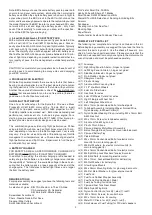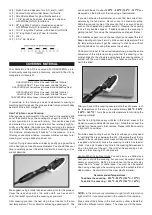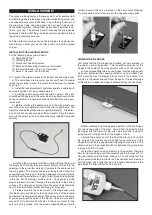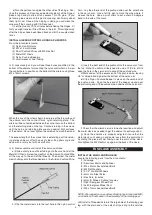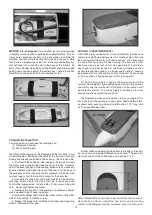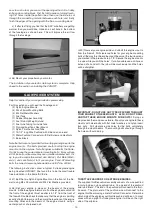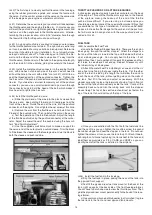
Note: BEC allows you to use the same battery pack to power both
your motor and your radio system, eliminating the normal radio
battery pack. When the single battery pack runs down in flight to
a prescribed point, the BEC circuit in the ESC will shut down the
motor and leave enough power to operate the radio while you land
the model. Note that the BEC feature in some cheaper ESCs does
not work with 4 cell and larger lipo battery packs - only 3 cell
packs. Check carefully to make sure you know all the specifica-
tions of the ESC that you are buying.
❑
4-6 cell 3000-4000mah LIPO BATTERY PACK
With a motor like those mentioned you can fly your Somethin’ Xtra
with a 4 cell (4S1P) or 6 cell (6S1P) lipo battery pack. Pack ca-
pacity should be 3000-4000 mah for good flight duration. Typically
a 4S pack with fly the model, but with limited aerobatic perform-
ance. The majority of you will be happiest with a 6S battery pack.
We find that 6s 4000mAh lipo packs provide between 8 to 10 min-
utes of flight time, depending on propeller selection and other fac-
tors (quality of pack, throttle management, outside temperature,
etc.).
CAUTION: You must match your propeller size to the cell count of
your lipo pack, to avoid drawing too many amps and damaging
your ESC or motor.
❑
PROPELLER FOR ELECTRIC
With electric powered models there are many factors that have a
bearing on what propeller to use. The best place to start answer-
ing that question is in the instructions that come with your motor.
Another fine source of information is one of the electric flight cal-
culators that are available for you to use free online (there is a
good one on Castle Creations web site).
OUR FLIGHT TEST REPORT
One of our favorite setups for the Somethin’ Xtra was a Maxx
Products® HC5018-530 motor with a 75 amp ESC, a 6-cell
(6S1P) 22.2v lipo pack, and an APC® 12x8E propeller. An APC
13x6.5E propeller also worked well. Both sizes delivered good
performance, reminiscent of a 2-stroke .46 glow engine. For a
starting prop we recommend the APC 12x8E. Other brand pro-
pellers of same size and similar design can also be used.
This combination gave outstanding flight performance. When
using a 6S 4000 mah lipo, we had flight times around 8-10 min-
utes, depending of course on throttle management. Your results
may vary. Prop size, size and quality of the battery pack, throttle
management, air temperature, etc., all have a bearing on electric
flight performance and flight time. Experiment to find the best
combination for your setup.
❑
BATTERY CHARGER
FOR SAFETY AS WELL AS PERFORMANCE, CHARGE LIPO
BATTERIES ONLY WITH A LIPO BATTERY CHARGER!
In addition to providing the critical charging profile needed to
safely charge lipo batteries, a lipo battery charger also includes
the capability of "balancing" the available voltage in the cells, en-
suring that the battery pack is at peak capacity at the end of the
charge cycle. This translates to better flight times and a longer
life from the battery pack.
REQUIRED TOOLS
For proper assembly, we suggest you have the following tools and
materials available:
A selection of glues - SIG Thin, Medium, & Thick CA Glue
CA Accelerator, CA Debonder
SIG Kwik-Set 5-Minute Epoxy
Screwdriver Assortment
Pliers - Needle Nose & Flat Nose
Diagonal Wire Cutters
Small Allen Wrench Assortment
Pin Vise for Small Dia. Drill Bits
Hobby Knife with Sharp #11 Blades
Small Power Drill With Selection of Bits
Dremel® Tool With Selection of Sanding & Grinding Bits
Scissors
Sandpaper
Covering Iron & Trim Seal Tool
Masking Tape
Paper Towels
Alcohol and/or Acetone For Epoxy Clean-up
COMPLETE KIT PARTS LIST
The following is a complete list of all parts contained in this kit.
Before beginning assembly, we suggest that you take the time to
inventory the parts in your kit. Use the check-off boxes
❑
pro-
vided in front of each part description. Please also note that the
bolts and nuts required to mount your engine to the motor mounts
are not included and must be purchased separately.
❑
(1) Fuselage
❑
(1) Right Wing Panel & Aileron, hinges not glued
❑
(1) Left Wing Panel & Aileron, hinges not glued
❑
(1) Stabilizer & Elevator, hinges not glued
❑
(1) Fin & Rudder, hinges not glued
❑
(1) Fiberglass Cowling
❑
(1) Plastic Canopy
❑
(1) Aluminum Main Landing Gear
❑
(2) 2-1/2" dia. Main Wheels
❑
(2) 4mm dia. Steel Axles
❑
(4) Hex Nuts; for axles
❑
(4) 4mm ID Wheels Collars; for axles
❑
(1) Right Fiberglass Wheel Pant
❑
(1) Left Fiberglass Wheel Pant
❑
(4) M3 x 10mm Socket-Head Bolts, for wheel pants
❑
(1) Tailwheel Assembly, including Wheel, Formed Wire,
Nylon Bearing, & Wheel Collars(2)
❑
(1) Nylon Rudder Steering Clasp, including M2 x 15mm Bolt
& M2 Hex Nut
❑
(2) M3 x 12mm Screw; for tailwheel assembly
❑
(1) Aluminum Tube Wing Joiner
❑
(2) Plastic Cinch Straps
❑
(1) Plywood Electric Motor Mount Assembly
❑
(1) Balsa Triangle Stock; for motor mount reinforcement
❑
(1) Plywood Battery Tray
❑
(2) Velcro® Straps
❑
(7) M4 x 20mm Socket-Head Bolts; for electric motor
mount(4) & main landing gear(3)
❑
(7) M4 Flat Washers; for electric motor mount(4) &
main landing gear(3)
❑
(4) M4 x 16mm Socket-Head Bolts; for electric motor
❑
(4) M4 Split-Ring Lock Washers; for electric motor
❑
(4) M4 Blind Nuts; for mounting electric motor
❑
(1) M3 x 12mm Socket-Head Bolt; for battery tray
❑
(1) M3 Flat Washer; for battery tray
❑
(2) Glow Engine Mounts
❑
(4) M4 x 25mm Mounting Bolts, for glow engine mounts
❑
(4) M4 Flat Metal Washers, for glow engine mounts
❑
(1) Fuel Tank
❑
(1) Fuel Tank Rubber Stopper Assembly
❑
(1) Fuel Tank Pick-Up Weight, Metal
❑
(1) Fuel Line Tubing, for inside tank
❑
(1) Plywood Fuel Tank Rear Mount
❑
(2) M6.5 Nylon Wing Bolts
❑
(4) Nylon Control Horns; for ail(2); elev(1); rud(1)
❑
(12) M2 x 15mm Screws; for control horns
❑
(4) M3 x 10mm Screws, for cowling
❑
(4) Metal R/C Clevis; for ail(2), ele(1), rud(1)
❑
(4) Small pieces of Fuel Tubing; for R/C clevis keepers
3



